固相合成
固相合成的原理及其应用
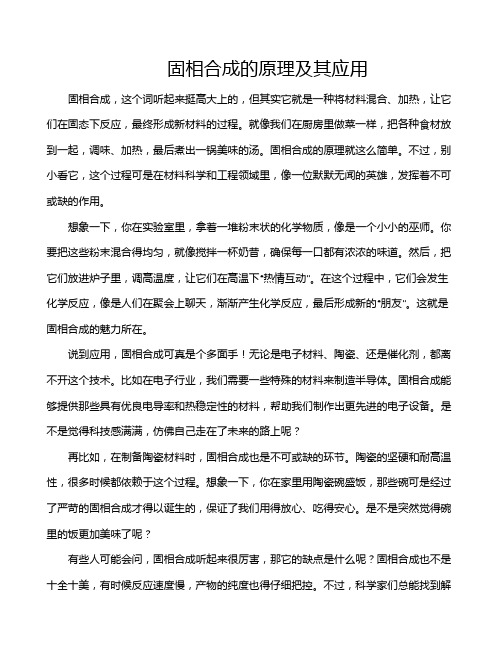
固相合成的原理及其应用固相合成,这个词听起来挺高大上的,但其实它就是一种将材料混合、加热,让它们在固态下反应,最终形成新材料的过程。
就像我们在厨房里做菜一样,把各种食材放到一起,调味、加热,最后煮出一锅美味的汤。
固相合成的原理就这么简单。
不过,别小看它,这个过程可是在材料科学和工程领域里,像一位默默无闻的英雄,发挥着不可或缺的作用。
想象一下,你在实验室里,拿着一堆粉末状的化学物质,像是一个小小的巫师。
你要把这些粉末混合得均匀,就像搅拌一杯奶昔,确保每一口都有浓浓的味道。
然后,把它们放进炉子里,调高温度,让它们在高温下“热情互动”。
在这个过程中,它们会发生化学反应,像是人们在聚会上聊天,渐渐产生化学反应,最后形成新的“朋友”。
这就是固相合成的魅力所在。
说到应用,固相合成可真是个多面手!无论是电子材料、陶瓷、还是催化剂,都离不开这个技术。
比如在电子行业,我们需要一些特殊的材料来制造半导体。
固相合成能够提供那些具有优良电导率和热稳定性的材料,帮助我们制作出更先进的电子设备。
是不是觉得科技感满满,仿佛自己走在了未来的路上呢?再比如,在制备陶瓷材料时,固相合成也是不可或缺的环节。
陶瓷的坚硬和耐高温性,很多时候都依赖于这个过程。
想象一下,你在家里用陶瓷碗盛饭,那些碗可是经过了严苛的固相合成才得以诞生的,保证了我们用得放心、吃得安心。
是不是突然觉得碗里的饭更加美味了呢?有些人可能会问,固相合成听起来很厉害,那它的缺点是什么呢?固相合成也不是十全十美,有时候反应速度慢,产物的纯度也得仔细把控。
不过,科学家们总能找到解决的办法,没事儿,总有办法让它更加完美嘛!比如,有些人会结合其他合成方法,比如溶液合成,来提高产物的质量,真是机智如你!固相合成的一个重要特点就是环保,嘿,没错,今天的科技发展可讲究环保。
固相合成一般不需要使用溶剂,减少了废物的产生。
就像咱们日常生活中提倡的“光盘行动”,少吃剩饭,减少浪费。
科学也是要有这种环保意识的嘛。
固相合成法的影响因素
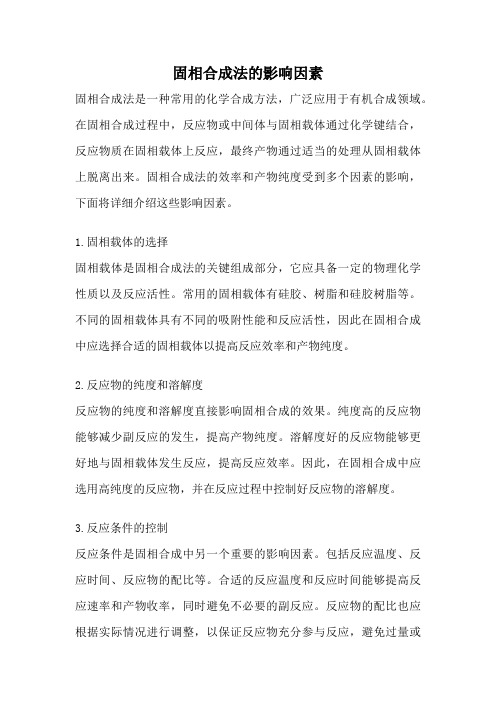
固相合成法的影响因素固相合成法是一种常用的化学合成方法,广泛应用于有机合成领域。
在固相合成过程中,反应物或中间体与固相载体通过化学键结合,反应物质在固相载体上反应,最终产物通过适当的处理从固相载体上脱离出来。
固相合成法的效率和产物纯度受到多个因素的影响,下面将详细介绍这些影响因素。
1.固相载体的选择固相载体是固相合成法的关键组成部分,它应具备一定的物理化学性质以及反应活性。
常用的固相载体有硅胶、树脂和硅胶树脂等。
不同的固相载体具有不同的吸附性能和反应活性,因此在固相合成中应选择合适的固相载体以提高反应效率和产物纯度。
2.反应物的纯度和溶解度反应物的纯度和溶解度直接影响固相合成的效果。
纯度高的反应物能够减少副反应的发生,提高产物纯度。
溶解度好的反应物能够更好地与固相载体发生反应,提高反应效率。
因此,在固相合成中应选用高纯度的反应物,并在反应过程中控制好反应物的溶解度。
3.反应条件的控制反应条件是固相合成中另一个重要的影响因素。
包括反应温度、反应时间、反应物的配比等。
合适的反应温度和反应时间能够提高反应速率和产物收率,同时避免不必要的副反应。
反应物的配比也应根据实际情况进行调整,以保证反应物充分参与反应,避免过量或不足。
4.反应物的保护基团选择在固相合成中,为了保护反应物不与固相载体发生非特异性反应,常常采用保护基团的策略。
保护基团的选择和保护基团的保护效果直接影响固相合成的效果。
合适的保护基团能够在反应过程中有效保护反应物,提高反应物的稳定性和反应活性。
5.反应物的缩合剂选择在固相合成中,常常需要使用缩合剂来促进反应物之间的缩合反应。
不同的缩合剂具有不同的反应活性和选择性,因此在固相合成中应根据实际需要选择合适的缩合剂。
合适的缩合剂能够提高反应活性和产物收率,同时避免不必要的副反应。
6.反应物的保护基团去除条件在固相合成中,反应物的保护基团去除是一个重要的步骤。
保护基团去除条件的选择直接影响产物纯度和产率。
共沉淀及固相合成法

共沉淀及固相合成法
共沉淀法(Co-precipitation method)是一种用于制备纳米材料
的方法。
该方法通过在溶液中混合两种或多种溶质,并在适当的条件下使其共同沉淀,从而得到纳米材料。
共沉淀法的基本步骤包括:1. 准备适当的金属盐溶液;2. 将不同金属盐溶液混合;3. 在适当的条件下(如温度、pH值等)
搅拌反应体系;4. 通过沉淀、洗涤和干燥等步骤获得纳米材料。
固相合成法(Solid-state synthesis method)是一种将固体反应
原料直接在高温下反应生成目标物质的方法。
这种方法不需要溶液作为反应介质,而是通过固体反应原料的相互作用形成产物。
固相合成法的基本步骤包括:1. 准备适当的固体反应原料;2. 将原料混合均匀;3. 在高温下进行反应;4. 冷却并收集产物。
共沉淀法和固相合成法都是制备纳米材料的常用方法,它们具有制备简单、操作容易等优点。
然而,不同的方法适用于不同的材料系统和制备要求,选择合适的方法是根据具体情况进行评估和决策的。
固相合成法实验流程

固相合成法实验流程一。
固相合成法,这可是化学领域里的一把“利剑”!简单来说,就是在固体状态下进行化学反应,从而合成我们想要的物质。
1.1 准备工作那可是关键。
就像打仗前要准备好武器一样,咱们做实验前也得把东西备齐喽。
得选好反应原料,这就好比挑好“种子”,质量得过硬。
然后呢,各种实验器具,什么反应容器、搅拌棒、温度计,一个都不能少,而且得保证干净、完好,不然就像“破车走烂路”,容易出岔子。
1.2 原料处理要精细。
原料到手可不能直接用,得进行一番处理。
该研磨的研磨,该提纯的提纯,把杂质都去掉,让原料“纯纯粹粹”,这样反应才能顺顺利利。
二。
接下来就是真正的“战斗”环节啦!2.1 反应条件要控制好。
温度、压力、反应时间,这可都是“命门”。
温度高了低了都不行,就像炒菜火候不对,味道就差了。
压力也要适中,过大过小都会影响反应效果。
反应时间更是关键,时间短了反应不完全,时间长了又可能产生副产物,得拿捏得恰到好处,这叫“恰到好处,事半功倍”。
2.2 搅拌操作不能少。
搅拌就像是给反应“煽风点火”,让反应物充分接触,加快反应速度。
搅拌速度也有讲究,太快太慢都不行,得根据具体情况来调整。
2.3 过程监控要及时。
反应进行中,得时刻盯着,就像看着自己的孩子一样,一点风吹草动都不能放过。
定期取样检测,看看反应进行到哪一步了,有没有偏离预期,一旦有问题,赶紧“对症下药”。
三。
最后就是收获成果啦!3.1 产物分离与提纯。
反应结束后,得把产物从混合物中分离出来,这可需要点技术和耐心。
然后进行提纯,把杂质彻底清除,让产物“出淤泥而不染”。
3.2 产物鉴定与分析。
分离提纯完,还得对产物进行鉴定和分析,看看是不是我们想要的东西,质量合不合格。
这就像是给成果“打分”,只有合格了,咱们这实验才算成功。
《固相有机合成》课件

固相有机合成的发展趋势
1
微流控技术
应用微流控技术可以提高反应效率、减少废料产生。
2
管球技术的应用
利用管球技术来加速反应速率,改善反应的均匀性。
3
新的反应底物的引入
研究者不断尝试引入新的反应底物,以扩展固相合成的适用范围。
总结
1 固相有机合成的意义
2. 底物的固定化
3. 反应的进行与监控
4. 合成产物的去除与纯化
2
固相合成的前期准备
1. 固相支持材料的表面功能化
2. 底物的选择与设计
3. 固相固定方法的选择
3
固相合成的反应
ቤተ መጻሕፍቲ ባይዱ
1. 底物与活化剂的反应
2. 底物之间的反应
3. 合成产物的去保护与收集
固相有机合成中的关键步骤
质量控制
确保底物、试剂和产物的质量稳定,以保证合成效果。
《固相有机合成》PPT课 件
固相有机合成是一种重要的化学合成方法,本课程将介绍固相合成的定义、 优势以及基本过程。
什么是固相有机合成?
固相有机合成是一种在固相材料上进行的有机化学反应来合成有机化合物的方法。 优势:高效、高纯度、易于分离产物。
固相合成的基本过程
1
固相合成的步骤
1. 固相支持材料的选择
固相有机合成为有机化学合成提供了高效、高纯度的方法。
2 固相有机合成的成就
固相有机合成在药物研发、新材料研究等领域取得了显著的成就。
3 固相有机合成中的挑战
质量控制、活化剂选择等是固相有机合成中需要面对的挑战。
活化剂的选用
选择适当的活化剂,加速反应速率并提高产率。
固相合成法及应用

固相合成法及应用固相合成法是一种把化学反应中的反应物固定在固相材料上进行反应的合成方法。
这种方法可以用于合成与有机化学、药物化学、材料化学等领域相关的化合物。
固相合成法具有反应条件温和、操作简便、高效率、高纯度等优点,因此在化学合成中得到了广泛的应用。
固相合成法最早应用于多肽的合成。
多肽是由α-氨基酸组成的生物分子,其合成过程中涉及到反应物的固定和反应的进行。
传统的多肽合成方法需要在溶液中进行,而固相合成法则可以将多肽的前体固定在固相材料上,并在反应过程中进行,大大提高了合成的效率和纯度。
固相合成法已经成为多肽合成领域的主流方法,广泛应用于药物研发、蛋白质工程等领域。
在药物化学中,固相合成法可以用于合成新药分子。
新药分子的合成往往需要进行大量的化学反应和结构修饰,传统的合成方法需要进行多道反应步骤,并需要分离纯化产物,费时费力。
而固相合成法则可以将反应物固定在固相材料上,反应后只需简单的洗涤和溶解等步骤即可得到目标产物。
这种方法不仅提高了合成效率,还减少了中间产物的损失和杂质的产生,保证了产物的纯度和质量。
因此,固相合成法能够实现高通量合成和高效率的药物研发,大大缩短合成周期和降低合成成本。
此外,固相合成法还在材料科学领域有着重要的应用。
材料的合成往往需要通过多步骤的反应来得到目标产物,而固相合成法则可以将反应物固定在固相材料上,实现多步骤反应的连续进行。
固相合成法可以用于制备各种材料,如金属氧化物、高分子材料、纳米材料等。
它可以控制材料的形貌、结构和性能,提高材料的纯度和稳定性。
固相合成法还可以用于合成催化剂、吸附剂和敏感材料,以及制备电池材料、传感器材料等。
总之,固相合成法是一种在化学合成中广泛应用的方法,能够在有机化学、药物化学和材料科学等领域合成各种化合物。
它的优点包括反应条件温和、操作简便、高效率和高纯度等。
固相合成法不仅提高了合成效率和纯度,还可以实现高通量合成和高效率的药物研发,以及制备各种材料。
固相合成法合成多肽的一般步骤

固相合成法合成多肽的一般步骤
固相合成法是一种常用的合成多肽的方法,它采用固定在固相载体上的起始氨基酸,通过循环的反应步骤逐渐扩大多肽链的长度。
下面是一般的固相合成多肽的步骤:
1. 选择合适的固相载体:常用的固相载体包括树脂或纳米粒子等。
载体上通常含有反应活性的官能团,以便于多肽链的延长。
2. 固相载体的活化:将固相载体与活化试剂(例如DIC、DCC等)进行反应,以提供反应所需的官能团。
3. 起始氨基酸的固定:将起始氨基酸与已活化的固相载体进行反应,使其固定在载体上。
4. 反应循环:重复以下步骤,逐渐扩大多肽链的长度:
a. 去保护基:使用适当的切割试剂去除氨基酸残基上的保护基。
b. 活化:将下一个氨基酸与已去保护的氨基酸残基进行反应,生成新的伸长部分。
5. 合成结束:在合成所需长度的多肽链合成完成后,将多肽链从固相载体上解离下来。
6. 去保护基:去除整个多肽链上的保护基,恢复对应的功能基团。
7. 纯化和表征:对合成得到的多肽进行纯化和分析,常用的方法包括高效液相色谱(HPLC)、质谱等。
需要注意的是,每一步骤都需要严格控制反应条件,遵循适当的化学法则和实验室操作规范,确保多肽的合成效果和质量。
固相合成法

固相合成法
固相合成法是一种物质制备方法,它以某种固体作为反应介质,通过有机、无机反应而引起的晶体增长形成新的物质。
其中,最常用的晶体生长介质包括氧化锆、二氧化硅和金刚石等。
在这种方法中,所有的反应物都是可溶性的。
反应发生时,原体积中的物质会沉淀出来,晶体就会在晶体的表面上生长。
固相合成法有以下优点:
1.反应温度可以控制在低温,避免有机物的失活和分解; 2.反应条件温和,不容易受到外界环境的干扰;3.可以节省原料和能源,并具有很好的经济效益; 4.可以产生高纯度的产物。
固相合成技术
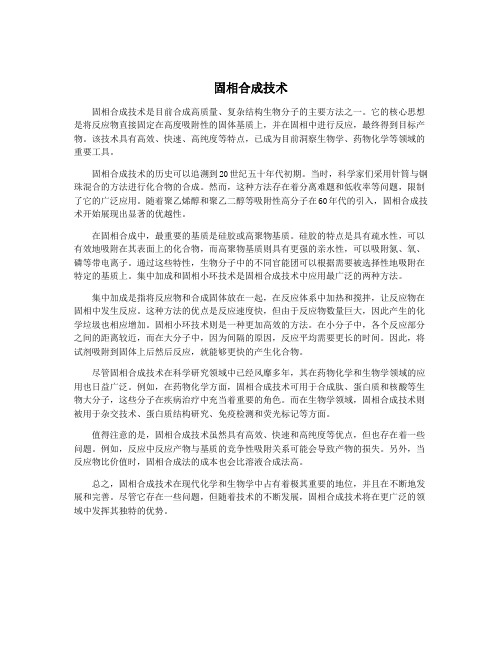
固相合成技术固相合成技术是目前合成高质量、复杂结构生物分子的主要方法之一。
它的核心思想是将反应物直接固定在高度吸附性的固体基质上,并在固相中进行反应,最终得到目标产物。
该技术具有高效、快速、高纯度等特点,已成为目前洞察生物学、药物化学等领域的重要工具。
固相合成技术的历史可以追溯到20世纪五十年代初期。
当时,科学家们采用针筒与钢珠混合的方法进行化合物的合成。
然而,这种方法存在着分离难题和低收率等问题,限制了它的广泛应用。
随着聚乙烯醇和聚乙二醇等吸附性高分子在60年代的引入,固相合成技术开始展现出显著的优越性。
在固相合成中,最重要的基质是硅胶或高聚物基质。
硅胶的特点是具有疏水性,可以有效地吸附在其表面上的化合物,而高聚物基质则具有更强的亲水性,可以吸附氮、氧、磷等带电离子。
通过这些特性,生物分子中的不同官能团可以根据需要被选择性地吸附在特定的基质上。
集中加成和固相小环技术是固相合成技术中应用最广泛的两种方法。
集中加成是指将反应物和合成固体放在一起,在反应体系中加热和搅拌,让反应物在固相中发生反应。
这种方法的优点是反应速度快,但由于反应物数量巨大,因此产生的化学垃圾也相应增加。
固相小环技术则是一种更加高效的方法。
在小分子中,各个反应部分之间的距离较近,而在大分子中,因为间隔的原因,反应平均需要更长的时间。
因此,将试剂吸附到固体上后然后反应,就能够更快的产生化合物。
尽管固相合成技术在科学研究领域中已经风靡多年,其在药物化学和生物学领域的应用也日益广泛。
例如,在药物化学方面,固相合成技术可用于合成肽、蛋白质和核酸等生物大分子,这些分子在疾病治疗中充当着重要的角色。
而在生物学领域,固相合成技术则被用于杂交技术、蛋白质结构研究、免疫检测和荧光标记等方面。
值得注意的是,固相合成技术虽然具有高效、快速和高纯度等优点,但也存在着一些问题。
例如,反应中反应产物与基质的竞争性吸附关系可能会导致产物的损失。
另外,当反应物比价值时,固相合成法的成本也会比溶液合成法高。
固相合成法实验流程
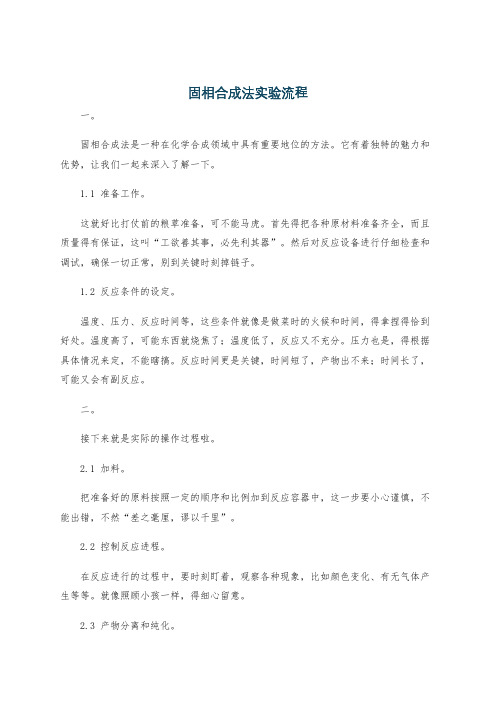
固相合成法实验流程一。
固相合成法是一种在化学合成领域中具有重要地位的方法。
它有着独特的魅力和优势,让我们一起来深入了解一下。
1.1 准备工作。
这就好比打仗前的粮草准备,可不能马虎。
首先得把各种原材料准备齐全,而且质量得有保证,这叫“工欲善其事,必先利其器”。
然后对反应设备进行仔细检查和调试,确保一切正常,别到关键时刻掉链子。
1.2 反应条件的设定。
温度、压力、反应时间等,这些条件就像是做菜时的火候和时间,得拿捏得恰到好处。
温度高了,可能东西就烧焦了;温度低了,反应又不充分。
压力也是,得根据具体情况来定,不能瞎搞。
反应时间更是关键,时间短了,产物出不来;时间长了,可能又会有副反应。
二。
接下来就是实际的操作过程啦。
2.1 加料。
把准备好的原料按照一定的顺序和比例加到反应容器中,这一步要小心谨慎,不能出错,不然“差之毫厘,谬以千里”。
2.2 控制反应进程。
在反应进行的过程中,要时刻盯着,观察各种现象,比如颜色变化、有无气体产生等等。
就像照顾小孩一样,得细心留意。
2.3 产物分离和纯化。
反应结束后,得把我们想要的产物从混合物中分离出来,然后进行纯化,去除杂质,这可是个精细活,得有耐心。
三。
最后就是对产物的检测和分析啦。
3.1 检测。
用各种仪器和方法对产物进行检测,看看是不是我们想要的东西,质量怎么样。
3.2 分析结果。
根据检测的结果进行分析,如果有问题,就得找出原因,下次改进。
固相合成法是个很有意思也很有挑战性的方法,只要我们认真对待,就能得到满意的结果。
有机化学的固相合成法
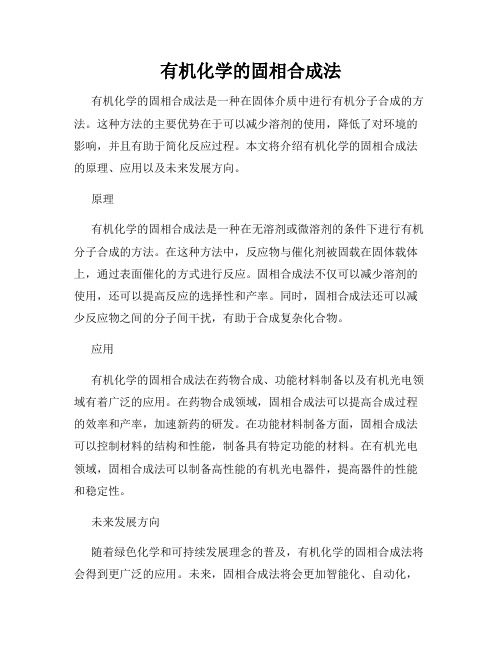
有机化学的固相合成法有机化学的固相合成法是一种在固体介质中进行有机分子合成的方法。
这种方法的主要优势在于可以减少溶剂的使用,降低了对环境的影响,并且有助于简化反应过程。
本文将介绍有机化学的固相合成法的原理、应用以及未来发展方向。
原理有机化学的固相合成法是一种在无溶剂或微溶剂的条件下进行有机分子合成的方法。
在这种方法中,反应物与催化剂被固载在固体载体上,通过表面催化的方式进行反应。
固相合成法不仅可以减少溶剂的使用,还可以提高反应的选择性和产率。
同时,固相合成法还可以减少反应物之间的分子间干扰,有助于合成复杂化合物。
应用有机化学的固相合成法在药物合成、功能材料制备以及有机光电领域有着广泛的应用。
在药物合成领域,固相合成法可以提高合成过程的效率和产率,加速新药的研发。
在功能材料制备方面,固相合成法可以控制材料的结构和性能,制备具有特定功能的材料。
在有机光电领域,固相合成法可以制备高性能的有机光电器件,提高器件的性能和稳定性。
未来发展方向随着绿色化学和可持续发展理念的普及,有机化学的固相合成法将会得到更广泛的应用。
未来,固相合成法将会更加智能化、自动化,提高反应的控制性和选择性。
同时,固相合成法还将会与其他合成方法相结合,开发出更加高效、环保的有机合成方法。
有机化学的固相合成法将会成为有机合成领域的重要发展方向。
结论在实践中,有机化学的固相合成法可以减少溶剂的使用,提高反应的选择性和产率,有利于环境保护和资源节约。
该方法具有广泛的应用前景,并且在未来会得到更多的研究和发展。
有机化学的固相合成法将会为有机化学领域的发展和创新注入新的活力。
化学技术中的固相合成技术及应用案例
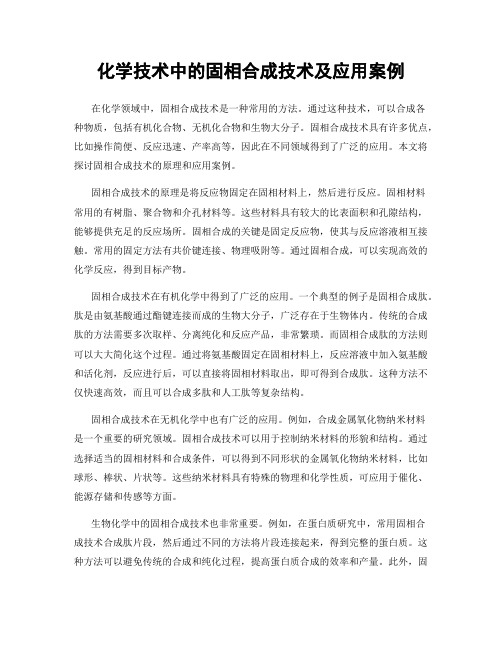
化学技术中的固相合成技术及应用案例在化学领域中,固相合成技术是一种常用的方法。
通过这种技术,可以合成各种物质,包括有机化合物、无机化合物和生物大分子。
固相合成技术具有许多优点,比如操作简便、反应迅速、产率高等,因此在不同领域得到了广泛的应用。
本文将探讨固相合成技术的原理和应用案例。
固相合成技术的原理是将反应物固定在固相材料上,然后进行反应。
固相材料常用的有树脂、聚合物和介孔材料等。
这些材料具有较大的比表面积和孔隙结构,能够提供充足的反应场所。
固相合成的关键是固定反应物,使其与反应溶液相互接触。
常用的固定方法有共价键连接、物理吸附等。
通过固相合成,可以实现高效的化学反应,得到目标产物。
固相合成技术在有机化学中得到了广泛的应用。
一个典型的例子是固相合成肽。
肽是由氨基酸通过酯键连接而成的生物大分子,广泛存在于生物体内。
传统的合成肽的方法需要多次取样、分离纯化和反应产品,非常繁琐。
而固相合成肽的方法则可以大大简化这个过程。
通过将氨基酸固定在固相材料上,反应溶液中加入氨基酸和活化剂,反应进行后,可以直接将固相材料取出,即可得到合成肽。
这种方法不仅快速高效,而且可以合成多肽和人工肽等复杂结构。
固相合成技术在无机化学中也有广泛的应用。
例如,合成金属氧化物纳米材料是一个重要的研究领域。
固相合成技术可以用于控制纳米材料的形貌和结构。
通过选择适当的固相材料和合成条件,可以得到不同形状的金属氧化物纳米材料,比如球形、棒状、片状等。
这些纳米材料具有特殊的物理和化学性质,可应用于催化、能源存储和传感等方面。
生物化学中的固相合成技术也非常重要。
例如,在蛋白质研究中,常用固相合成技术合成肽片段,然后通过不同的方法将片段连接起来,得到完整的蛋白质。
这种方法可以避免传统的合成和纯化过程,提高蛋白质合成的效率和产量。
此外,固相合成技术还可以用于合成核酸、寡核苷酸和寡肽等生物大分子,成为生物医学研究的重要工具。
总之,固相合成技术在化学技术中有着广泛的应用。
化学技术中的固相合成技术及应用案例
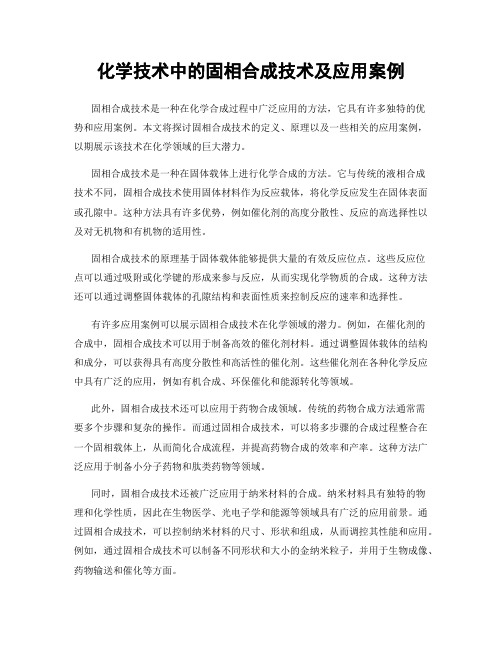
化学技术中的固相合成技术及应用案例固相合成技术是一种在化学合成过程中广泛应用的方法,它具有许多独特的优势和应用案例。
本文将探讨固相合成技术的定义、原理以及一些相关的应用案例,以期展示该技术在化学领域的巨大潜力。
固相合成技术是一种在固体载体上进行化学合成的方法。
它与传统的液相合成技术不同,固相合成技术使用固体材料作为反应载体,将化学反应发生在固体表面或孔隙中。
这种方法具有许多优势,例如催化剂的高度分散性、反应的高选择性以及对无机物和有机物的适用性。
固相合成技术的原理基于固体载体能够提供大量的有效反应位点。
这些反应位点可以通过吸附或化学键的形成来参与反应,从而实现化学物质的合成。
这种方法还可以通过调整固体载体的孔隙结构和表面性质来控制反应的速率和选择性。
有许多应用案例可以展示固相合成技术在化学领域的潜力。
例如,在催化剂的合成中,固相合成技术可以用于制备高效的催化剂材料。
通过调整固体载体的结构和成分,可以获得具有高度分散性和高活性的催化剂。
这些催化剂在各种化学反应中具有广泛的应用,例如有机合成、环保催化和能源转化等领域。
此外,固相合成技术还可以应用于药物合成领域。
传统的药物合成方法通常需要多个步骤和复杂的操作。
而通过固相合成技术,可以将多步骤的合成过程整合在一个固相载体上,从而简化合成流程,并提高药物合成的效率和产率。
这种方法广泛应用于制备小分子药物和肽类药物等领域。
同时,固相合成技术还被广泛应用于纳米材料的合成。
纳米材料具有独特的物理和化学性质,因此在生物医学、光电子学和能源等领域具有广泛的应用前景。
通过固相合成技术,可以控制纳米材料的尺寸、形状和组成,从而调控其性能和应用。
例如,通过固相合成技术可以制备不同形状和大小的金纳米粒子,并用于生物成像、药物输送和催化等方面。
总结起来,固相合成技术是一种在化学合成领域中具有广泛应用的方法。
它利用固体载体提供的反应位点,实现化学物质的合成和调控。
该技术在催化剂合成、药物合成和纳米材料合成等领域具有许多应用案例。
固相法合成工艺流程
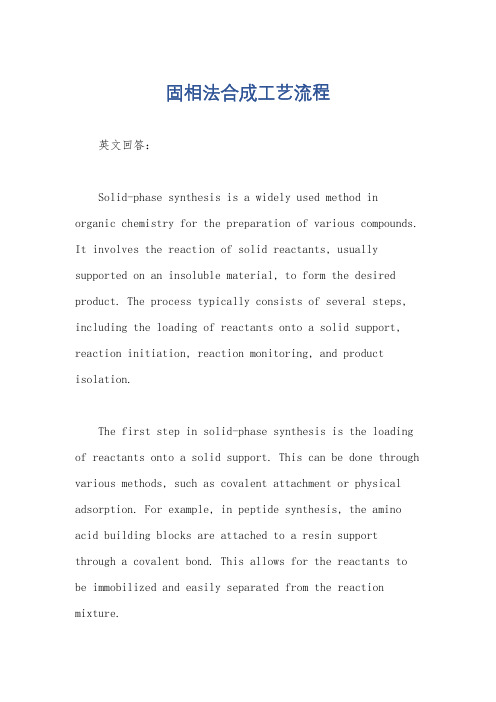
固相法合成工艺流程英文回答:Solid-phase synthesis is a widely used method in organic chemistry for the preparation of various compounds. It involves the reaction of solid reactants, usually supported on an insoluble material, to form the desired product. The process typically consists of several steps, including the loading of reactants onto a solid support, reaction initiation, reaction monitoring, and product isolation.The first step in solid-phase synthesis is the loading of reactants onto a solid support. This can be done through various methods, such as covalent attachment or physical adsorption. For example, in peptide synthesis, the amino acid building blocks are attached to a resin support through a covalent bond. This allows for the reactants to be immobilized and easily separated from the reaction mixture.Once the reactants are loaded onto the solid support, the reaction can be initiated. This is typically done by adding a suitable reagent or catalyst to the reaction mixture. The reaction can be carried out under various conditions, such as room temperature or elevated temperature, depending on the nature of the reactants and the desired product. The reaction progress can be monitored using various techniques, such as spectroscopy or chromatography.After the reaction is complete, the product needs to be isolated from the solid support. This can be achieved through various methods, such as filtration or solvent extraction. In some cases, additional purification steps, such as column chromatography or recrystallization, may be required to obtain a pure product. Once the product is isolated, it can be characterized using various analytical techniques, such as NMR or mass spectrometry.Solid-phase synthesis offers several advantages over traditional solution-phase synthesis. Firstly, it allowsfor the synthesis of complex molecules by enabling the stepwise addition of reactants. This is particularly useful in peptide synthesis, where the amino acids are added oneby one to form the desired sequence. Secondly, solid-phase synthesis eliminates the need for extensive purification steps, as the product is already immobilized on a solid support. This can save time and resources. Lastly, solid-phase synthesis allows for the automation of the synthesis process, making it more efficient and reproducible.中文回答:固相法合成是有机化学中广泛使用的一种合成方法,用于制备各种化合物。
固相合成_精品文档

固相合成多肽固相合成的一般方法1、1材料与试剂1、1、1树脂二氯三苯甲基树脂(以下简称二氯树脂)和Wang树脂在多肽的固相合成中应用最为广泛,反应条件温和,价格低廉。
将这两种树脂与Fmoc-氨基酸通过共价键连接,得到相应的氨基酸树脂。
其中二氯树脂与氨基酸的连接反应是一个不可逆的取代反应,Wang树脂与氨基酸的连接反应是一个可逆的酯化反应,因此理论上要比二氯树脂的性能要优于Wang树脂。
孙立枢等通过实验也发现以二氯树脂作载体,第一个氨基酸的连接率,以及目标肽的纯度和产率都要明显高于Wang树脂。
郑彦慧等对RinkAmide(氨基树脂)的研究发现合成多肽时低取代度(即树脂的loading值低)、高溶胀度的树脂能获得较好的肽收率。
1、1、2氨基酸根据氨基酸的α-氨基的保护基不同,可分为Fmoc-氨基酸和Boc-氨基酸两种,本实验室采用的是Fmoc-氨基酸。
很多氨基酸不仅α-氨基需要保护,其侧链上的氨基也要保护以有利于合成环肽或避免干扰反应。
例如:Fmoc-Ly(alloc)-OH,Fmoc-Trp(Boc)-OH,Fmoc-Ap(oall)-OH等等。
1、1、3溶剂实验中主要使用的溶剂有DMF,DCM,MeOH。
DMF能很好地溶解氨基酸,以及用语Wang树脂的溶胀。
DCM用于二氯树脂的溶胀,并且在氨基酸反应时加入密度较大的DCM有利于树脂飘浮起来。
MeOH对树脂的作用于DMF、DCM相反,它使树脂收缩,因此在合成直链肽的最后常用MeOH与DCM交替冲洗树脂,树脂在一胀一缩中被彻底地清洗干净。
1、1、4缩合剂由于缩合方法不同,缩合剂也有多种。
常见的有:HATU,HBTU,TBTU,DIC,HOBt(偶联助剂,常与其他缩合剂组合使用),DMAP等等。
针对要连接的氨基酸序列的不同可选用不同的缩合剂。
1、1、5有机碱有机碱为反应提供了碱性环境,有利于游离-NH2的稳定。
可选择NMM,DIEA等。
1、1、6检测液KaierTet的检测液有A、B、C三种液体:A液,20%无水乙醇+80%苯酚[7][6]B液,吡啶C液,5g茚三酮+100ml无水乙醇。
固相合成原理
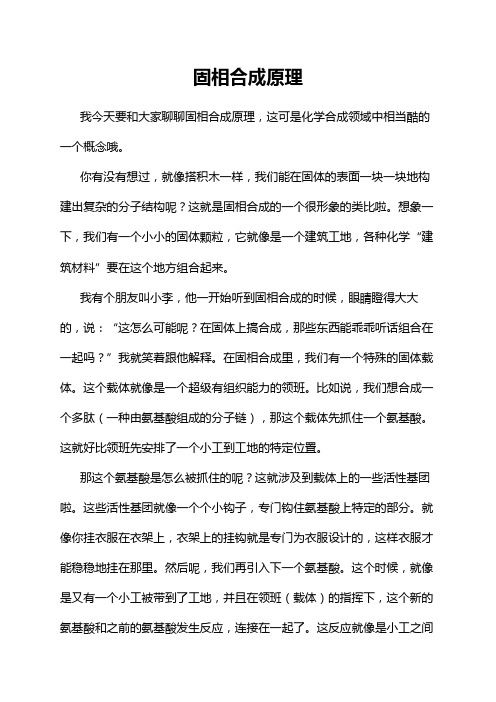
固相合成原理我今天要和大家聊聊固相合成原理,这可是化学合成领域中相当酷的一个概念哦。
你有没有想过,就像搭积木一样,我们能在固体的表面一块一块地构建出复杂的分子结构呢?这就是固相合成的一个很形象的类比啦。
想象一下,我们有一个小小的固体颗粒,它就像是一个建筑工地,各种化学“建筑材料”要在这个地方组合起来。
我有个朋友叫小李,他一开始听到固相合成的时候,眼睛瞪得大大的,说:“这怎么可能呢?在固体上搞合成,那些东西能乖乖听话组合在一起吗?”我就笑着跟他解释。
在固相合成里,我们有一个特殊的固体载体。
这个载体就像是一个超级有组织能力的领班。
比如说,我们想合成一个多肽(一种由氨基酸组成的分子链),那这个载体先抓住一个氨基酸。
这就好比领班先安排了一个小工到工地的特定位置。
那这个氨基酸是怎么被抓住的呢?这就涉及到载体上的一些活性基团啦。
这些活性基团就像一个个小钩子,专门钩住氨基酸上特定的部分。
就像你挂衣服在衣架上,衣架上的挂钩就是专门为衣服设计的,这样衣服才能稳稳地挂在那里。
然后呢,我们再引入下一个氨基酸。
这个时候,就像是又有一个小工被带到了工地,并且在领班(载体)的指挥下,这个新的氨基酸和之前的氨基酸发生反应,连接在一起了。
这反应就像是小工之间互相递工具,然后一起合作完成一个小任务。
我记得有一次在实验室里,看到师兄在做固相合成实验。
他一边操作一边跟我说:“你看,这每一步都得小心翼翼的,就像走钢丝一样。
”他说的没错。
因为在固相合成中,如果有一步出了差错,就可能像多米诺骨牌一样,后面的反应都会受到影响。
比如说,如果一个氨基酸没有正确地连接到上一个氨基酸上,那后面继续添加氨基酸的时候,整个分子链就会“歪歪扭扭”,甚至无法形成我们想要的多肽结构。
在这个过程中,还有很多化学反应在悄悄地进行。
为了让氨基酸之间能够顺利连接,我们要使用一些特殊的试剂。
这些试剂就像是化学反应的催化剂,或者说是小工们的“超级能量饮料”。
它们能让氨基酸之间的反应更快更高效地进行。
固相合成cpg
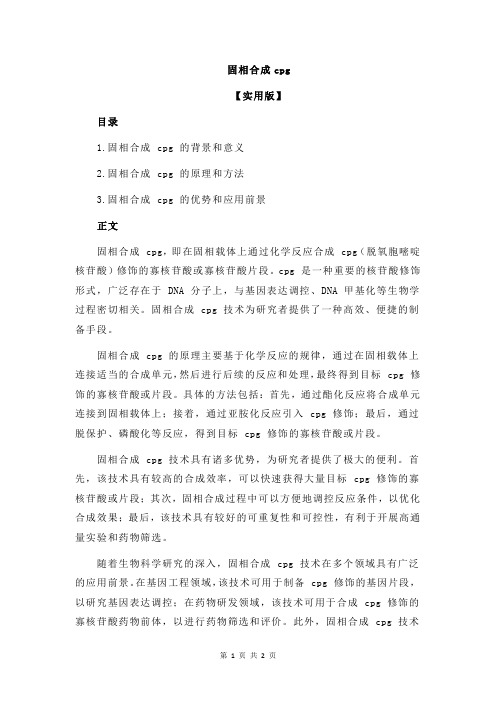
固相合成cpg【实用版】目录1.固相合成 cpg 的背景和意义2.固相合成 cpg 的原理和方法3.固相合成 cpg 的优势和应用前景正文固相合成 cpg,即在固相载体上通过化学反应合成 cpg(脱氧胞嘧啶核苷酸)修饰的寡核苷酸或寡核苷酸片段。
cpg 是一种重要的核苷酸修饰形式,广泛存在于 DNA 分子上,与基因表达调控、DNA 甲基化等生物学过程密切相关。
固相合成 cpg 技术为研究者提供了一种高效、便捷的制备手段。
固相合成 cpg 的原理主要基于化学反应的规律,通过在固相载体上连接适当的合成单元,然后进行后续的反应和处理,最终得到目标 cpg 修饰的寡核苷酸或片段。
具体的方法包括:首先,通过酯化反应将合成单元连接到固相载体上;接着,通过亚胺化反应引入 cpg 修饰;最后,通过脱保护、磷酸化等反应,得到目标 cpg 修饰的寡核苷酸或片段。
固相合成 cpg 技术具有诸多优势,为研究者提供了极大的便利。
首先,该技术具有较高的合成效率,可以快速获得大量目标 cpg 修饰的寡核苷酸或片段;其次,固相合成过程中可以方便地调控反应条件,以优化合成效果;最后,该技术具有较好的可重复性和可控性,有利于开展高通量实验和药物筛选。
随着生物科学研究的深入,固相合成 cpg 技术在多个领域具有广泛的应用前景。
在基因工程领域,该技术可用于制备 cpg 修饰的基因片段,以研究基因表达调控;在药物研发领域,该技术可用于合成 cpg 修饰的寡核苷酸药物前体,以进行药物筛选和评价。
此外,固相合成 cpg 技术在 DNA 甲基化研究、基因治疗、基因诊断等领域也具有潜在的应用价值。
总之,固相合成 cpg 技术为研究者和生物产业界提供了一种高效、便捷的制备手段,具有广泛的应用前景。
固相合成的特点
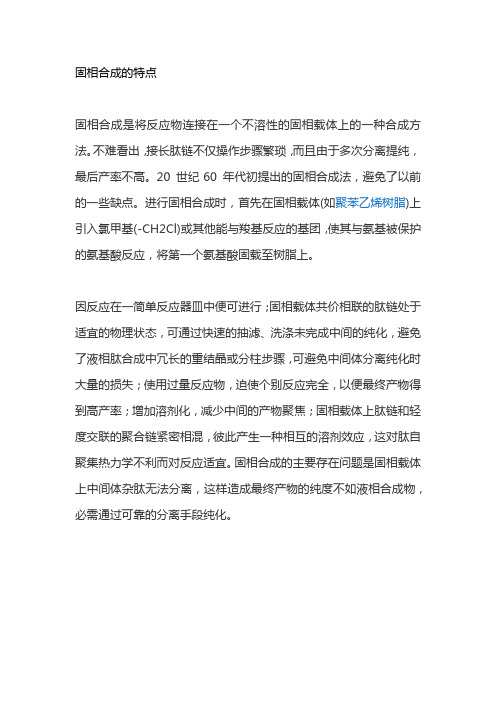
固相合成的特点
固相合成是将反应物连接在一个不溶性的固相载体上的一种合成方法。
不难看出,接长肽链不仅操作步骤繁琐,而且由于多次分离提纯,最后产率不高。
20 世纪60 年代初提出的固相合成法,避免了以前的一些缺点。
进行固相合成时,首先在固相载体(如聚苯乙烯树脂)上引入氯甲基(-CH2Cl)或其他能与羧基反应的基团,使其与氨基被保护的氨基酸反应,将第一个氨基酸固载至树脂上。
因反应在一简单反应器皿中便可进行;固相载体共价相联的肽链处于适宜的物理状态,可通过快速的抽滤、洗涤未完成中间的纯化,避免了液相肽合成中冗长的重结晶或分柱步骤,可避免中间体分离纯化时大量的损失;使用过量反应物,迫使个别反应完全,以便最终产物得到高产率;增加溶剂化,减少中间的产物聚焦;固相载体上肽链和轻度交联的聚合链紧密相混,彼此产生一种相互的溶剂效应,这对肽自聚集热力学不利而对反应适宜。
固相合成的主要存在问题是固相载体上中间体杂肽无法分离,这样造成最终产物的纯度不如液相合成物,必需通过可靠的分离手段纯化。
- 1、下载文档前请自行甄别文档内容的完整性,平台不提供额外的编辑、内容补充、找答案等附加服务。
- 2、"仅部分预览"的文档,不可在线预览部分如存在完整性等问题,可反馈申请退款(可完整预览的文档不适用该条件!)。
- 3、如文档侵犯您的权益,请联系客服反馈,我们会尽快为您处理(人工客服工作时间:9:00-18:30)。
自发极化
• 铁电性的微观机制来自于自发极化,钙钛 矿铁电体和其他一些含氧八面体铁电体的 自发极化主要来源于B离子偏离八面体中心 沿四重轴、二重轴和三重轴的位移的运动, 分别对应四方相、正交相和三角相,在立 方相中,Ti离子位于氧八面体中心,整个晶 体无自发极化,是顺电相。合成工艺对材 料的微观结构影响较大,因此材料性能与 合成工艺关系非常密切。
• 1 高温炉 • 2 球磨机 • 3 成型机 • 4 磨床 • 5 检测仪器
第2节 固相合成举例
• 1 压电陶瓷,如PZT等 Pb3O4 + ZrO2 + TiO2 → Pb (Zr1-x,Tix)O3 • 2 铁氧体,如ZnFe2O4 ,BaFe12O19等
Fe2O3 + ZnO = ZnFe2O4 • 3 微波电介质陶瓷,如BaTi4O9等
PbTiO3, PbZrO3
• PbTiO3和PbZrO3是铁电体和反铁电体的典 型代表,Zr和Ti属于同一副族,PbTiO3和 PbZrO3具有相似的空间点阵形式,但两者 的宏观特性却有很大的差异。
居里温度
• 铁电(或反铁电)陶瓷只在某一温度范围 内才具有铁电(反铁电)性,当温度高于 临界温度Tc时,铁电(或反铁电)相转变 为顺电相,自发极化消失,这个临界温度 Tc就称为铁电(或反铁电)陶瓷的居里温 度。居里温度高,能在很宽的范围内调整 性能以满NiO+Fe2O3
如何加速固相反应?
• 1)增加T • 2)采用微细的原料 • 3)采用活性高的原料,用碳酸盐比用氧化
物反应速度要快 • 4)原料压制成块比散料反应要快 • 5)其它
先进固相合成技术
• 1 微波加速合成:极性物质能强烈吸收微波。 • 2 电流加速合成
固相合成主要设备
Microwave ceramics
• Pacific ceramics
Effects of zinc substitution on crystal structure and microwave
dielectric properties of CaLa4Ti5O17 ceramics 2009-04-19 Journal of the American Ceramic Society, Vol.89, No.11
第2章 材料的合成与制备
2012年9月24日
本章内容
• 第1节 高温固相合成法 • 第2节 液相相合成法 • 第3节 气相合成法 • 第4节 单晶制备技术 • 第5节 高纯材料制备技术
材料形态
1 宏观体态: • 块体 • 粉体 ,包括球状 • 片状体 • 纤维体 • 管状体 • 多孔体,包括泡沫材料 • 薄膜 2 微观体态:纳米线;纳米棒,纳米管等 3 晶态:多晶态;单晶态;非晶态
合成方法
• 为了获得性能优良的PZT陶瓷,人们研究并尝试 了各种合成方法:①固相烧结法;②溶胶凝胶法; ③共沉淀法;④水热合成法;⑤球磨法等。
• 溶胶凝胶法、共沉淀法、水热合成法化学方法合 成出的样品纯度和均匀性比较好,但其工艺复杂 且成本高。固相烧结法是PZT传统的制备方法, 需高温。由于PbO在高温时易挥发,所以对反应 环境要求比较高。球磨法又称机械化合金技术, 该技术最大的优点是在室温下可以获得纳米量级 的粉末,这对含有Pb的材料合成更有利,避免了 由于PbO的挥发而产生的成分丢失 。
• Zinc-substituted CaLa4Ti5O17 microwave dielectric ceramics with the composition of Ca1-xZnxLa4Ti5O17 (x=0-1) were prepared by a solid-state reaction method. The effects of zinc substitution on sintering behavior, crystal structure, and microwave dielectric properties of CaLa4Ti5O17 ceramics were investigated. Zinc substitution can effectively lower the sintering temperature of CaLa4Ti5O17 ceramics from 1500 degrees to 1100 degrees C. X-ray diffraction and Raman spectra analysis reveal that with increasing zinc content, the n value of the A(n)B(n)O(3n+2) structures changed and distinct compounds formed. With increasing Zn2+ content, the perovskite-slabs decreased from 5-[BO6] to 4.5-[BO6] in the range of 0.13 <= x <= 0.2, and then collapsed to 4-[BO6] at about x=0.6, with Zn2TiO4 as the secondary phase. The microwave dielectric properties of the sintered ceramics vary with the Zn2+ content. The present ceramics with a small amount of zinc substitution show a relatively small temperature coefficient of resonant frequency of 4.9-8.7 ppm/degrees C, epsilon(r) of 57-58, and a Q x f value of 11 300-17 400 GHz. When x=0.01, the best combination of dielectric properties, a near-zero temperature coefficient of resonant frequency of tau(f)similar to 4.9 ppm/degrees C, epsilon(r)similar to 57.6, and Q x f similar to 17 100 GHz, is obtained.
BaCO3 + 4TiO2 = BaTi4O9+ CO2 • 4 超导体,如YBCO Y2O3 + 4BaO + 6CuO + 1/2O2= 2YBa2Cu3O7
压电陶瓷
PZT
• 二元系压电陶瓷锆钛酸铅(PbZrxTi1-xO3简称PZT)是目前 应用最广泛的压电铁电陶瓷材料。由于它具有优异的压电、 介电、热电特性而受到广泛的关注,锆钛酸铅是PbZrO3 和PbTiO3的固溶体,具有ABO3
• 从结构看,晶胞中的B位置可以是Ti4+,也可以是Zr4+, 随Zr/Ti比例不同,结构发生变化。在室温下x<0.53为四方 铁电相FT;0.53<X<0.95为正交反铁电相Ao;x=0.53附近 存在一条三角-四方相界,称为准同型相界,在该相界区 域内,铁电四方相和铁电三方相两相共存,自发极化的取 向增多,因而在准同型相界附近时,PZT具有最强的压电 性能,如:耦合系数大、压电系数大,居里温度高等优点 型钙钛矿结构
第1节 固相合成法
• 固相反应的特点: 1 反应在界面进行; 2 反应的控制步骤常是离子扩散过程; 3 合成过程常是不彻底的,所以反应产物常是不纯
的。 • 固相反应优缺点: 优点:工艺简单,不需溶剂,环保性好等 缺点: 反应时间长效率低,反应温度高耗能多,有的
反应物在高温下挥发或分解等。
MgO, Al2O3, MgAl2O4
Research and development of microwave dielectric ceramics for
wireless communications
• Intense research and development of microwave and millimeterwave dielectric materials is expected for applications in the wireless communications in the ubiquitous age. There are three important directions for research and development of microwave and millimeterwave dielectric materials. We have been studying on these three directions based on the crystallography. In the first direction for miniaturization of mobile equipments, tungsten-bronzetype like Ba6-3xR8+2xTi18O54 (R = rare earth) solid solutions with high dielectric constant have been studied to improve quality factor based on the compositional ordering of cations. For the second direction for applications in mobile phone base stations, we have developed homologous ALa4Ti4O15 (A = Ba, Sr and Ca) compounds with excellent dielectric properties such as high dielectric constant and high quality factor. For the third direction, dielectric ceramics of silicate compounds such as forsterite Mg2SiO4 and willemite Zn2SiO4, and alumina are expected for millimeterwave applications. The dielectric ceramics with high quality factor are obtained by using high purity raw materials. Temperature coefficients of resonant frequency τf of these materials are improved adding rutile with high positive τf.
